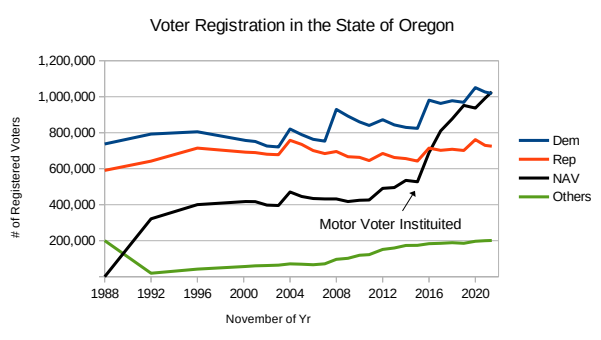The Oregon Fix

This is the first of a series of articles intended to raise visibility to potential fraud in Oregon elections. Since we cannot obtain access to the ballots from the 2020 election we cannot say for certain what happened then, but there are several indications which cause a reasonable person to doubt it’s integrity. Once the mechanisms are understood, we advocate for corrective action.
Part 1: Motor Voter Phantom Voters
Throughout the country the term “Phantom Voter” has been used to describe a name on the voter rolls which will reliably not vote. This might be because voter rolls indicate that they have never voted in the past, or they are known to be unable to vote (like an Alzheimer's patient) or a dead person whose name has not been removed from the rolls. It is my understanding that voter rolls have also been hacked so that names could be added for a few days only around the time of the election to create more Phantom Voters. These entries in the voter rolls are important because they can be used to generate fraudulent votes to sway an election.
In Oregon there are actually several ways to generate Phantom Voters legally, the most obvious one being the Motor Voter law. Under Oregon law, every US citizen who visits their Department of Motor Vehicles to obtain or renew a drivers license or ID card automatically is registered to vote. This law was implemented in January of 2016 and has inflated the voter rolls by registering a large number of people who are minimally interested in voting, or else they probably would have already registered, probably under a political party. When at the DMV the licensee has the chance to specify a political party, but if no preference is stated on the form, the individual is registered as a non-affiliated voter (NAV). And, of course, in addition to flooding the voter registration rolls with minimally interested voters, these are a large block of voters available for use as Phantom Voters. This graph shows how the number of NAV registrants have increased since the law was put into effect so that currently (April, 2022) it is the largest block of voters in Oregon.
From Oregon SoS website.

But apparently the Motor Voter Law doesn’t generate enough phantom voters. In 2021, after the 2020 election the Oregon legislature passed HB2681. In the past Oregon law specified that people who didn’t vote for 10 years would be moved to an inactive status. When inactive, a person is still on the voter rolls, but not able to vote. HB2681, mandates instead that those people will remain in an active status. An active voter who hasn’t voted in 10 years is the perfect vehicle for a phantom vote.
Once a Phantom Voter is identified, other tools can be used in combination with this knowledge to obtain a ballot for that person and turn it in to be counted. In Oregon we have legislated lax requirements for voter registration, mail in voting, and ballot harvesting. The tools are certainly available.
A patriot’s prayer: Father God, we look to you for justice in Oregon, we are willing to do what you tell us to do, but we are powerless to change this system on our own. Please act through us and through others in Oregon to bring about a higher level of justice.